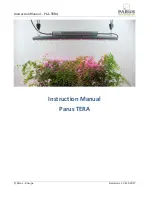
Radial Engineering Ltd.
StageDirect™ Active Direct Box
True to the Music
®
9
using the 180° polarity reverse
Resonant feedback generally occurs when a powerful low-frequency
wave on stage causes the top of the instrument to vibrate. This low
frequency wave may be produced by the stage monitors, PA system,
stage amp or a combination as they interact together in the acoustic
space. When two waves from different speakers collide in phase they
can increase in amplitude causing a resonant peak or ‘hot spot’ on stage.
If this hot spot happens to be where you are standing your instrument will
likely begin to feedback.
+
=
A
B
+
=
A
B
A
B
In-phase frequencies from the fl oor monitor (A) and the stage amp
(B) combine and create a feedback hotspot.
By changing the polarity (or relative phase) of the direct box output, one
of the two waves can be inverted which will cause phase cancellation and
instead of a hot spot, it creates a ‘null’. you can often use this technique
to electronically move the resonant frequency out of the way and achieve
more gain before the onset of feedback.
+
=
A
B
+
=
A
B
A
B
Inverting the polarity of the XLR output reverses the phase of the fl oor monitor (A)
and creates a null when combined with the stage amp (B).
The StageDirect has two 180° polarity reverse switches. One is for the
lo-Z XLR output and reverses pin-2 and pin-3. The other is on the hi-Z
AMP output and reverses the phase of the signal going to your amp. Try
changing the polarity going to the PA fi rst, then your stage amp to fi nd the
combination that works best.
Phase inverts the
polarity of the hi-Z ¼”
AMP output.
180° inverts the
polarity of the lo-Z
XLr output.


































